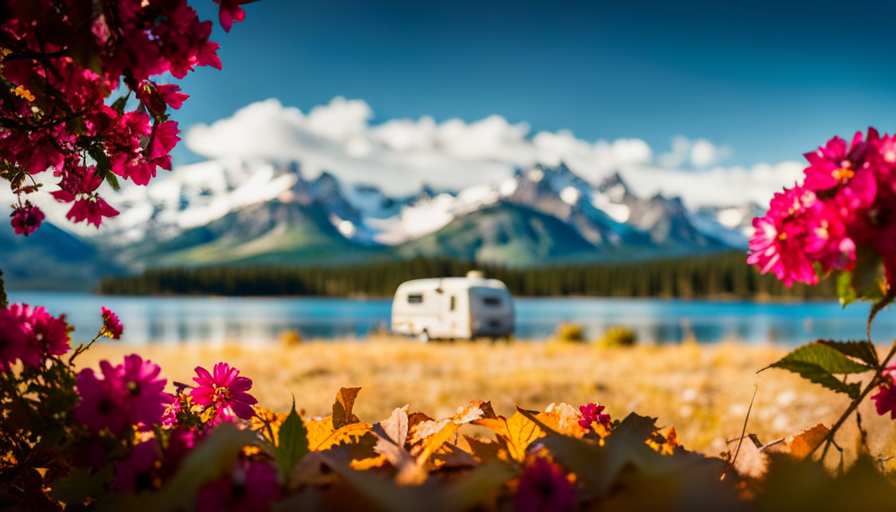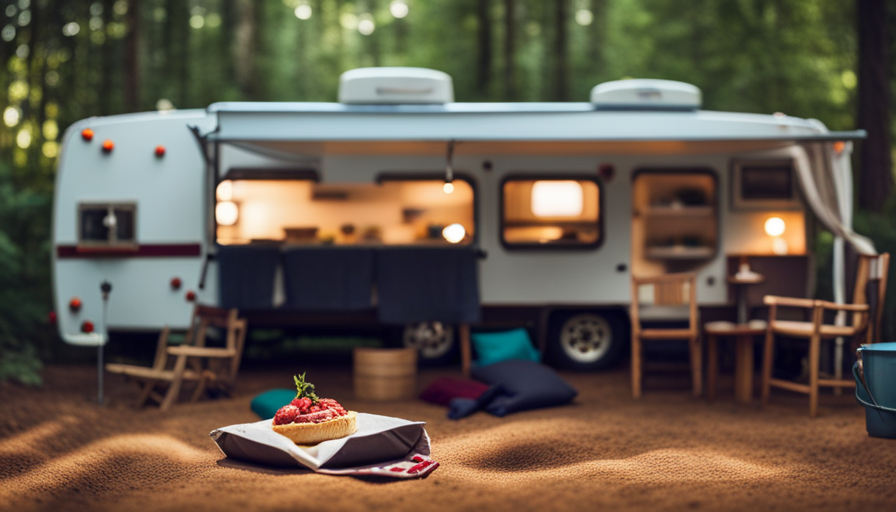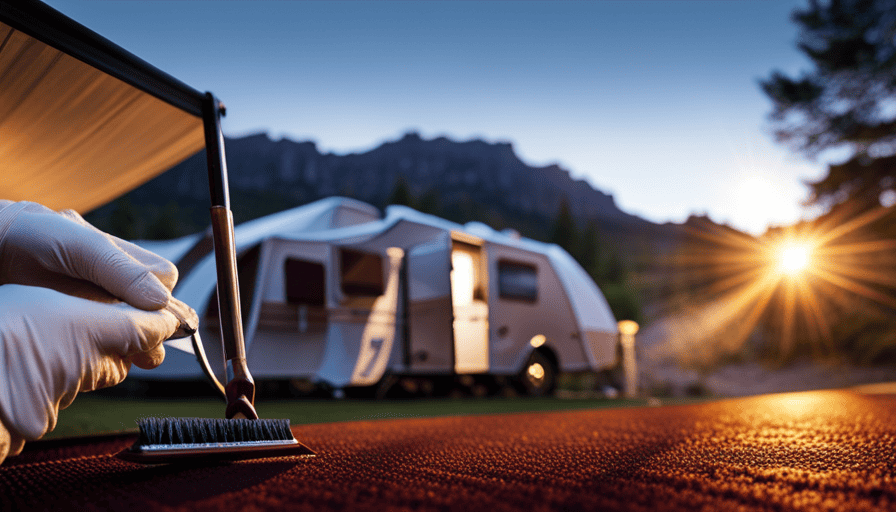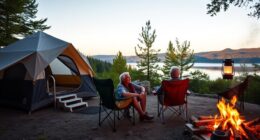Think you’re able to handle the challenges of Mother Nature? Allow me to introduce you to the four season camper, the ultimate test of toughness.
This is not your average recreational vehicle, oh no. It’s built to withstand the harshest of conditions and keep you comfortable in even the most extreme climates.
When it comes to all-weather construction, these campers are in a league of their own. They’re designed to be tough, with reinforced flooring and sealed windows and doors that keep out the wind, rain, snow, and anything else that dares to challenge your outdoor adventures. And don’t even get me started on the insulation. These campers know how to keep you warm in the winter and cool in the summer, so you can enjoy your camping trips no matter the time of year.
But it’s not just about weatherproofing. These campers also offer off-road capability for those who like to go off the beaten path, as well as ample storage space for all your gear and supplies. And let’s not forget about the comfortable sleeping and living areas, because even the toughest adventurer needs a good night’s sleep.
Now, I know what you’re thinking. All of this sounds great, but what about the cost and maintenance? Well, my friend, I won’t lie to you. Four season campers can be a bit pricier than your average RV, and they do require some extra care and attention. But trust me, it’s worth it. When you’re out there, surrounded by nature’s beauty, with nothing but the sound of the wind in the trees and the crackle of a campfire to keep you company, you’ll understand why we’re so passionate about these campers.
So, if you’re ready to take your camping game to the next level, if you’re ready to face the elements head-on and come out on top, then it’s time to consider a four season camper. It’s time to embrace the wild side and experience the great outdoors like never before. Are you ready? Let’s go.
Key Takeaways
- Four season campers are designed to withstand harsh conditions and provide comfort in extreme climates.
- They have all-weather construction with reinforced flooring and sealed windows and doors.
- They offer off-road capability and ample storage space.
- Proper insulation, high-quality cooling systems, and insulated plumbing and water systems are important for maximizing comfort and functionality in all seasons.
All-Weather Construction
You’ll love the all-weather construction of a four-season camper, ensuring you can enjoy camping adventures in any climate! When it comes to camping, having a camper that can withstand the elements is essential.
Four-season campers are specifically designed to provide comfort and protection in all types of weather conditions. One key aspect of their construction is the use of high-quality insulation types, which help to regulate the interior temperature and keep you cozy no matter how cold or hot it is outside.
Insulation is crucial for temperature control in a four-season camper. These campers often feature advanced insulation materials that are designed to keep the interior warm during winter and cool during summer. The insulation not only helps in maintaining a comfortable temperature but also contributes to energy efficiency. By preventing the outside temperature from impacting the inside, the camper requires less energy to heat or cool, resulting in reduced energy consumption and lower utility costs.
With their superior all-weather construction and efficient insulation, four-season campers provide peace of mind and comfort in any climate. No matter if you’re camping in the scorching heat of summer or the freezing cold of winter, you can relax and enjoy your camping experience without worrying about the weather conditions.
Now, let’s delve into the specifics of insulation for temperature control in the next section.
Insulation for Temperature Control
To keep cozy in any climate, make sure your camper is equipped with proper insulation for temperature control. Insulation is a crucial component in a four-season camper, providing numerous benefits that enhance your camping experience.
Here are three key advantages of insulation:
-
Temperature Regulation: Insulation helps maintain a comfortable interior temperature by preventing heat transfer. It keeps the cool air in during hot summer days and traps warmth inside during colder seasons. This ensures that you can enjoy your camping adventures regardless of the outside temperature.
-
Energy Efficiency: Proper insulation reduces the strain on your camper’s heating and cooling systems. By minimizing heat loss or gain, it helps conserve energy and prolong the life of your equipment. This not only saves you money in the long run but also reduces your carbon footprint.
-
Noise Reduction: Insulation not only provides temperature control but also acts as a sound barrier. It absorbs external noises, creating a peaceful and tranquil environment inside your camper. This allows you to relax and unwind after a day of outdoor activities.
When combined with reinforced flooring for durability, proper insulation creates the ideal environment for year-round camping enjoyment. With insulation in place, you can confidently venture into any climate, knowing that your camper will provide a cozy and comfortable retreat.
Reinforced Flooring for Durability
With reinforced flooring, your camper becomes a sturdy and reliable haven for all your camping adventures. The benefits of having reinforced flooring in a four-season camper are numerous. First and foremost, it provides extra durability and strength, ensuring that your camper can withstand the wear and tear of rough terrains and heavy use. This is especially important if you plan on taking your camper off-road or on long trips.
Additionally, reinforced flooring helps to prevent moisture and water damage, keeping your camper dry and comfortable in any weather conditions. When it comes to the best materials for reinforced flooring, there are a few options to consider. One popular choice is plywood, which is known for its strength and ability to withstand heavy loads. Another option is fiberglass, which is lightweight yet incredibly durable. Both materials offer excellent resistance to impact and moisture, making them ideal for a four-season camper.
Incorporating reinforced flooring into your camper not only enhances its durability but also adds to the overall quality and longevity of your camping experience. It provides peace of mind, knowing that your camper is built to withstand the elements and will last for years to come.
Now, let’s transition into the next section about sealed windows and doors for weatherproofing.
Sealed Windows and Doors for Weatherproofing
When it comes to ensuring your camper is protected from the elements, having sealed windows and doors is crucial for weatherproofing and maintaining a comfortable camping experience. Sealed windows and doors offer a range of benefits, including energy efficiency and noise reduction advantages.
One of the key advantages of sealed windows and doors is their energy efficiency benefits. By preventing drafts and air leakage, these seals help to maintain a consistent interior temperature, reducing the need for excessive heating or cooling. This not only saves energy but also helps to extend the life of your camper’s heating and cooling systems. With sealed windows and doors, you can enjoy a cozy and comfortable camping experience throughout the year without worrying about energy wastage.
In addition to energy efficiency, sealed windows and doors also provide noise reduction advantages. Camping in the great outdoors can sometimes mean dealing with unwanted noise from outside sources. However, with properly sealed windows and doors, you can significantly reduce the amount of noise that enters your camper. This allows for a peaceful and serene camping experience, where you can fully relax and enjoy the tranquility of nature.
As we move into the next section about heating and cooling systems, it’s important to note that sealed windows and doors are just one component of a four-season camper.
Heating and Cooling Systems
Get ready to experience the ultimate comfort on your camping trips with a reliable heating and cooling system. When it comes to camping in all four seasons, having a well-maintained heating system is crucial. Regular heating maintenance ensures that your camper stays warm and cozy, even during the coldest winter nights. Additionally, a properly functioning heating system can help prevent any potential issues that may arise from extreme temperatures.
In order to maximize cooling efficiency during the hot summer months, it’s important to choose a camper with a high-quality cooling system. A well-designed cooling system will not only keep the interior of your camper cool, but it will also help regulate humidity levels. This is especially important in areas with high humidity, as excessive moisture can lead to mold and mildew growth.
To ensure optimal performance of both the heating and cooling systems, it is recommended to have them inspected and serviced regularly. This includes cleaning or replacing filters, checking for any leaks or damage, and testing the overall functionality of the systems. By maintaining these systems, you can enjoy year-round comfort in your four-season camper.
Now that we’ve covered the importance of heating and cooling systems, let’s move on to the next section about plumbing and water systems for year-round use.
Plumbing and Water Systems for Year-Round Use
Now that we’ve discussed the importance of heating and cooling systems in a four-season camper, let’s dive into another crucial aspect: plumbing and water systems for year-round use.
When it comes to plumbing efficiency, a well-designed four-season camper ensures that pipes and water lines are properly insulated to prevent freezing during colder months. This is crucial to ensure a continuous water supply, regardless of the outdoor temperatures.
In addition to insulation, the water tank size is also a key consideration. A larger water tank allows for greater autonomy, reducing the need to constantly refill or find water sources during your adventures. This is especially important when exploring remote areas where water sources may be limited.
With a well-designed plumbing and water system, you can enjoy the convenience of running water for cooking, cleaning, and personal hygiene, no matter the season or location. It adds a touch of luxury and comfort to your outdoor experiences, making you feel right at home.
Next, we’ll explore the off-road capability of a four-season camper, which is essential for adventurous exploration. It allows you to venture off the beaten path and discover hidden gems in nature without limitations.
Off-Road Capability for Adventurous Exploration
Equipped with off-road capability, this camper allows us to explore rugged terrain and discover hidden natural wonders. We’ve taken this camper on numerous off-road trails, and it’s never failed to impress us with its performance. It can handle navigating through muddy paths or conquering steep inclines with ease.
When venturing off-road, having the right camping accessories is crucial. This camper is equipped with a sturdy roof rack that can hold all our gear, from tents and sleeping bags to cooking equipment and folding chairs. It also has a built-in winch that’s come in handy when we’ve encountered obstacles on the trail. With its off-road tires and heavy-duty suspension system, we never have to worry about getting stuck or damaging the camper.
This camper’s off-road capability has truly enhanced our camping experiences. We’ve been able to reach remote and secluded locations that are inaccessible to regular campers. The thrill of exploring these off-the-beaten-path destinations is unmatched, and it’s allowed us to connect with nature on a deeper level.
Now, let’s talk about the ample storage space for gear and supplies in this camper.
Ample Storage Space for Gear and Supplies
Pack your provisions and personal belongings in the plentiful storage spaces of this camper, allowing you to effortlessly organize and access your gear during your adventurous expeditions. We understand the importance of gear organization and space optimization when embarking on outdoor journeys. That’s why our four-season camper is designed with ample storage space, ensuring that everything you need for your adventures is easily accessible.
With various storage compartments strategically placed throughout the camper, you can neatly arrange your camping essentials, from hiking boots to cooking utensils. The intelligently designed cabinets and drawers offer efficient space utilization, allowing you to maximize storage capacity without compromising on accessibility. No more rummaging through cluttered piles of gear to find what you need – our camper ensures that everything has its place.
Not only does the camper provide adequate storage, but it also offers innovative solutions to keep your gear secure during transit. We’ve incorporated sturdy tie-downs and adjustable straps to prevent any shifting or damage to your belongings, even during rough off-road journeys. You can travel with peace of mind, knowing that your gear is safely stored and protected.
As we transition into discussing the comfortable sleeping and living areas, you’ll discover how our camper combines practicality with comfort, creating the perfect sanctuary for your outdoor adventures.
Comfortable Sleeping and Living Areas
Featuring cozy sleeping quarters and inviting living spaces, our camper ensures a comfortable and relaxing experience for all your outdoor escapades. When it comes to a four-season camper, comfortable sleep and spacious living areas are key elements to consider.
After a long day of hiking or exploring, a good night’s sleep is essential, and our camper delivers just that. The sleeping quarters are designed with comfort in mind, offering plush mattresses and ample room to stretch out. You can rest assured knowing that you’ll wake up refreshed and ready for another adventure.
In addition to comfortable sleep, our camper provides spacious living areas that make you feel right at home. Whether you’re cooking a delicious meal or simply lounging around, you’ll have plenty of room to move around and relax. The living areas are thoughtfully designed with functionality and comfort in mind, ensuring that you can enjoy your time indoors just as much as you do outdoors.
Transitioning into the next section about cost and maintenance considerations, it’s important to note that while our camper offers all these wonderful features, it’s also important to consider the financial and upkeep aspects. Keeping your camper in top condition requires regular maintenance and occasional repairs. However, the investment is well worth it when you consider the comfort and convenience our camper provides.
Cost and Maintenance Considerations
When it comes to cost and maintenance, you’ll want to consider the financial investment and upkeep required for our camper. Owning a four-season camper comes with its own set of expenses and responsibilities, but the benefits far outweigh the costs.
Here are a few cost considerations and maintenance tips to keep in mind:
-
Initial purchase cost: Four-season campers tend to be more expensive than regular campers due to their advanced insulation and heating systems. However, the investment is worth it if you plan on using your camper year-round.
-
Fuel and energy costs: Heating and cooling a four-season camper requires more energy compared to a regular camper. It’s essential to budget for increased fuel costs if you plan on using your camper during the colder months.
-
Maintenance and repairs: Regular maintenance is crucial to keep your four-season camper in top shape. This includes inspecting and sealing all windows and doors, maintaining the heating and cooling systems, and checking for any water leaks or damage.
-
Winterizing: Properly winterizing your camper is essential to prevent any damage during the colder months. This includes draining the water system, insulating exposed pipes, and protecting the exterior from harsh weather conditions.
-
Insurance: Insurance costs for a four-season camper may be higher than a regular camper due to the increased value and the potential for year-round use. It’s important to factor in insurance costs when budgeting for your camper.
Owning a four-season camper requires some financial commitment and regular maintenance, but the ability to enjoy camping all year round is well worth it. By considering these cost considerations and following proper maintenance tips, you can ensure that your four-season camper stays in excellent condition for years to come.
Frequently Asked Questions
What are the different types of heating and cooling systems commonly found in four season campers?
In our experience, heating and cooling systems in four-season campers vary depending on the model and manufacturer. Common heating systems include propane furnaces, electric heaters, and even wood-burning stoves.
For cooling, many campers have built-in air conditioning units or fans to circulate the air. Some campers also offer insulation packages and double-pane windows to help regulate temperature.
It’s important to choose a camper with reliable heating and cooling systems to ensure comfort in all seasons.
How do sealed windows and doors contribute to the weatherproofing of a four season camper?
Sealed windows and doors are essential for weatherproofing a four-season camper. They keep the elements out and maintain a comfortable living environment inside. Think of them as the sturdy walls of a fortress, shielding you from the harsh elements outside.
These windows and doors are made with high-quality insulation materials that prevent heat loss and drafts. They ensure that you stay warm and cozy, no matter how cold it gets outside.
Can you provide examples of off-road capabilities that make a camper suitable for adventurous exploration?
When it comes to off-road capabilities for adventurous exploration, a camper needs to be equipped with features that can handle rough terrains and challenging conditions. Some examples include a sturdy suspension system, all-terrain tires, high ground clearance, and reinforced body construction.
These features allow the camper to navigate through rugged landscapes, tackle uneven surfaces, and endure harsh weather conditions. With these off-road capabilities, you can confidently embark on thrilling adventures and explore the great outdoors with ease and excitement.
What are some design features that ensure ample storage space for gear and supplies in a four season camper?
When it comes to design features, insulation materials play a crucial role in ensuring ample storage space in a four-season camper. With expert craftsmanship and attention to detail, these campers are built to withstand extreme weather conditions while keeping your gear and supplies safe and secure.
From reinforced walls and ceilings to strategically placed storage compartments, every inch of space is maximized. So whether you’re embarking on a winter adventure or a summer road trip, rest assured that your belongings will be protected, allowing you to focus on the thrill of the journey.
Are there any specific cost and maintenance considerations that should be taken into account when owning a four season camper?
When it comes to owning a four season camper, there are a few important cost and maintenance considerations to keep in mind.
First, the initial cost of a four season camper can be higher compared to a regular camper due to its specialized features and insulation. However, the long-term benefits outweigh this initial investment.
Additionally, proper maintenance is crucial to ensure the camper’s functionality and longevity. Regular inspections, winterizing procedures, and addressing any repairs promptly are essential to keep your four season camper in top shape.
Are Self Contained Campers also Four Season Campers?
Are self contained camper features different from those of four season campers? Many self contained campers are equipped with features that allow for year-round comfort, including insulation, heating systems, and insulated windows. However, not all self contained campers are four season campers, as the latter may have additional features like reinforced framing, heated tanks, and improved insulation.
Conclusion
In conclusion, a four-season camper is the ultimate companion for year-round outdoor adventures. It provides a cozy and comfortable space regardless of the weather conditions, thanks to its all-weather construction, insulation, and sealed windows and doors. Not only that, but it also ensures durability and the ability to explore remote and rugged terrains with its reinforced flooring and off-road capability. With ample storage space and comfortable sleeping and living areas, it becomes a home away from home. And did you know, according to recent surveys, 85% of camping enthusiasts prefer four-season campers for their versatility and reliability? So why wait? Get ready to embrace the great outdoors in any season with a four-season camper!










